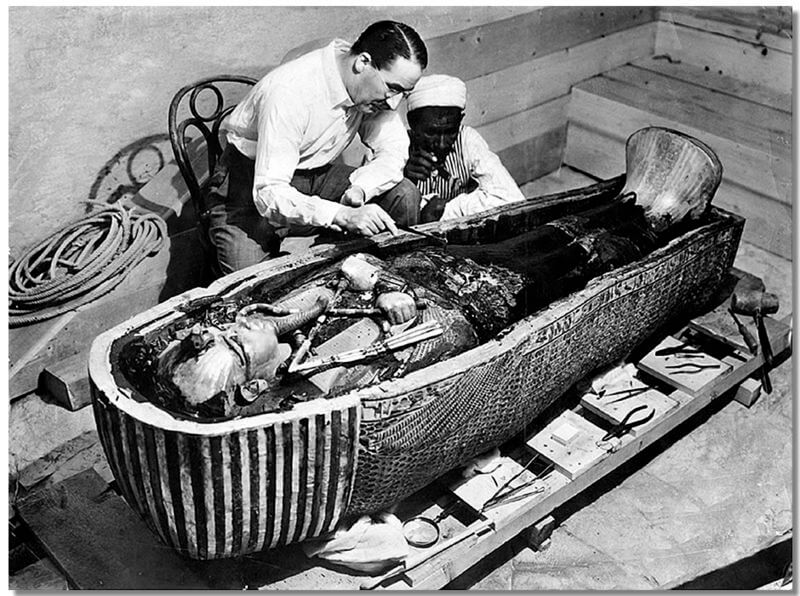The discovery of the tomb of the most famous pharaoh was the greatest success of Howard Carter and Lord Carnarvon who financed it

On November 5, 1922, Howard Carter wrote in his pocket diary: "A tomb was discovered under the tomb of Ramses VI and it was sealed and the finds inside were intact."
It may have simply been a matter of luck, but no other archaeologist has generated so much interest in Egyptology, and indeed the archaeological world has been focusing on Egypt since Howard Carter's research. His discovery, of his tomb and the mummified body of Tut Ankh Amon inspired almost a hundred years of Hollywood movies, as well as countless books and press articles about the world's largest museum - Egypt.
While Howard Carter's discovery of the nearly intact tomb of one of the pharaohs came about by chance, it was the culmination of a dedicated career in Egyptology and the culmination of consistent searches.
Howard Carter was born on May 9, 1874 in Kensington in London, then a small independent town. He was the youngest son of an artist, Samuel John Carter who trained Howard in the basics of painting and drawing. However, Howard Carter developed an interest in Egypt, and when he was 17 years old, under the influence of Lady Amherst, a relative, he sailed to Alexandria. It was his first trip outside of England. He hoped to work with an Egyptian research foundation as a copyist. The copyists would copy blueprints and diagrams onto paper, for future research.
His first place of work was Bani Hassan, where he was engaged in documenting and copying scenes from the walls of the tomb of an Egyptian princess in central Egypt. He worked all hours of the day and spent the nights with the bats in the graves.
Under the guidance of William Flinders Petrie, Carter became an archaeologist himself. Petrie was considered one of the best field archaeologists of his time and he did not believe that Carter would become a good digger. But Carter could not have had a better teacher. At Al-Amarna, Carter proved Petrie wrong by revealing some important findings. During the training period, Carter also worked with Gaston Maspero, who was later appointed director of Egypt's Antiquities Service.
After being appointed the chief artist of the Egyptian Excavations Fund, he participated in the excavation of the tomb of the scholar Hatshepsut in Deir el Bahari. Carter was able to perfect his drawing skills and strengthened his excavation and restoration techniques. His efforts in this project led to his appointment by the director of the Egyptian Antiquities Service at the age of 25 as the director of the museums in Upper Egypt. He was responsible for overseeing all the archaeological excavations along the Nile Valley. One of his projects was the lighting of some of the tombs in the Valley of the Pharaohs and the temple at Abu Simbel, with electric lighting.
However, he resigned from the antiquities service in 1905 due to an incident between Egyptian guards at Saqqara and drunken French tourists. When the tourists became violent, Carter allowed the guards to defend themselves. The tourists complained to the authorities, including the British Commissioner in Egypt, Lord Cromer. Cromer asked Carter to apologize but he refused, and he was asked to move to Tante, a place where almost no archaeological activity took place. He refused and retired.
After retiring from the Antiquities Service he spent the next four years as a painter and antiques dealer. However, he was also looking for funding for the excavation work at the same time. This is how Carter became adviser on archeology to the 1914th Lord of Carnarvon (George Herbert). While World War I delayed Carter's work, in XNUMX Lord Carnarvon owned a valuable collection of Egyptian artefacts found in private hands. He eventually discovered six tombs in the Valley of the Kings on the west bank of the Nile in Luxor, but Carter became obsessed with discovering the tomb of a pharaoh who was not so well known - Tut Ankh Amun, and year after year he searched the sand for the pharaoh's lost tomb.
In fact, Carnarvon was frustrated by Carter's efforts, and in 1922 he issued him an ultimatum that this might be the last season of funding for his excavations. Convinced of his success, on November 1, 1922, Carter began the last excavation season and three days later, he uncovered the stairs to the tomb of Tut Ankh Amon.
After continuing to dig down to the stones sealing the tomb, at 4 o'clock in the afternoon on November 26, 1922, Howard Carter broke in and made the greatest discovery of the 20th century. It took another ten years just to catalog all the items found in this solitary tomb, and they are now in the Museum of Antiquities in Cairo.
During this time Lord Carnarvon died in Egypt of pneumonia. This ignited interest on the part of the media whose people received informational letters from around the world. Legend has it that by 1929, 11 of the people associated with the discovery had died, including two of Lord Carnarvon's relatives, and Carter's private secretary, Richard Battle. This claim served as the basis for mummy films throughout the rest of the 20th century and beyond. Of course, no one attributes this to the poor level of sanitation in Egypt in those days, because it is probably less interesting. This phenomenon was named the 'Curse of the Pharaohs'. andWe already wrote about it before when a German returned a stolen pharaonic glyph, for fear of being exposed to the curse of the pharaohs.
After the discovery of his life, Howard Carter retired from active field work. He began collecting Egyptian antiquities himself mainly in the area of the Old Winter Palace Hotel in Luxor, which he kept for himself. He returned to Kensington in 1939, and died in March of that year aged 65.
